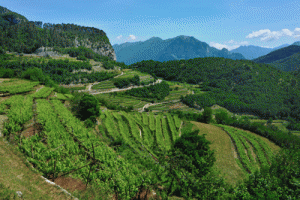The territory of corrugated Gresta Valley is located south of Trentino
and comprises the area bounded by step Bordola north from Mount Biaena east and west from Mount Creino; it is included in the district of Vallagarina that extends to the east, and to the west is the territory of Upper Lake Garda and the Sarca. The Gresta Valley is characterized by the “ridges” of the mountains that compose it and the terraces that border the river Rio Gresta and influenced by the mild climate of the lake, have made it known as the “organic garden of Trentino”. the Gresta Valley is administered by the municipalities of Ronzo-Chienis and that of the Moors.
TERRITORY OF GRESTA VALLEY
Province: Trento
Commons: Ronzo-Chienis, Mori (Pannone,Valle S. Felice, Varano, Manzano and Nomesino) The Gresta Valley is a real valley but a kind of terraced amphitheater surrounded by woods and rocks. It has a typical Mediterranean landscape, and when you get here you will be fascinated by the contrast of colors where the blue of the sky blends with the gray of the rocks of the flat black with the green of the meadows. A flourishing agriculture thanks to the mild climate, in fact the farmers of this valley have become specialists in the techniques of organic production thus protect the health and environment. In the valley small clusters of old stone houses built in small churches in the area to remember the deep religiosity of the people. In summer, temperatures reach 25-30 degrees and winter the temperature drops below degrees even if I compared to other valleys snows here shortly. Located in the southern part of the Trentino region and is bordered by the mountain Biaiena east and west from Mount Creino.
Commons: Ronzo-Chienis, Mori (Pannone,Valle S. Felice, Varano, Manzano and Nomesino) The Gresta Valley is a real valley but a kind of terraced amphitheater surrounded by woods and rocks. It has a typical Mediterranean landscape, and when you get here you will be fascinated by the contrast of colors where the blue of the sky blends with the gray of the rocks of the flat black with the green of the meadows. A flourishing agriculture thanks to the mild climate, in fact the farmers of this valley have become specialists in the techniques of organic production thus protect the health and environment. In the valley small clusters of old stone houses built in small churches in the area to remember the deep religiosity of the people. In summer, temperatures reach 25-30 degrees and winter the temperature drops below degrees even if I compared to other valleys snows here shortly. Located in the southern part of the Trentino region and is bordered by the mountain Biaiena east and west from Mount Creino.
HISTORY OF GRESTA VALLEY
Gardumo is its old name and the name Gresta comes from the place where the castle was built in 1225. Important place of traffic between Lake Garda and the Adige still retains evidence of fortifications dating back to the Middle Ages, among them the ancient church and the birth of Gardumo family who built the castle, which subsequently passed to Castelbarcos. Gardumo is divided into nine smaller communities that corresponded to the countries most important, there was an administrative unit that can be compared to our municipality where the head was the Massaro (like our mayor) who was elected by the villagers who had joined from what for us today is the city council. When the valley that had previously fallen under the Venetian rule came under the Austrian Empire in the sixteenth century, the Gresta took back their jurisdictions with great benefit to their reputation although the population was in serious difficulty. And it is here that many families of farmers over agricultural activity began the breeding of silkworms. The plague of 1629-1630 led to the death one-third of the population and 700 at the beginning of the Trentino was involved in the War of the Spanish Succession, also in 1703, the French troops retreating razed the villages of Valle del Sarca destroying the castles of arc. Loppio and Gresta and destroying even the whole parish archives with official documents of the valley. The economic consequences were disastrous until monarchical absolutism of Maria Theresa and Joseph II of Austria gave a positive turning point for the quality of life of the people in both bureaucratic and for the abolition of many privileges that were given to local lords. In 1810, Napoleon aggregated the Four Vicariate (Wing, Avio, Brentwood and Mori) to the Kingdom of Italy announcing decayed feudal privileges, civil and ecclesiastical, and noting the equality of all citizens. The Four Vicariate returned to the Tyrol under the government of Insbruck and since they were border line were built forts, trenches, shelters armored everywhere. Evacuated in 1915 because of the bad relations between Italy and Austria, the people, the war was over they returned to their home countries where it began reconstruction.
LOCAL PRODUCTS AND LOCAL CUISINE OF GRESTA VALLEY
Biological fruits and vegetables
